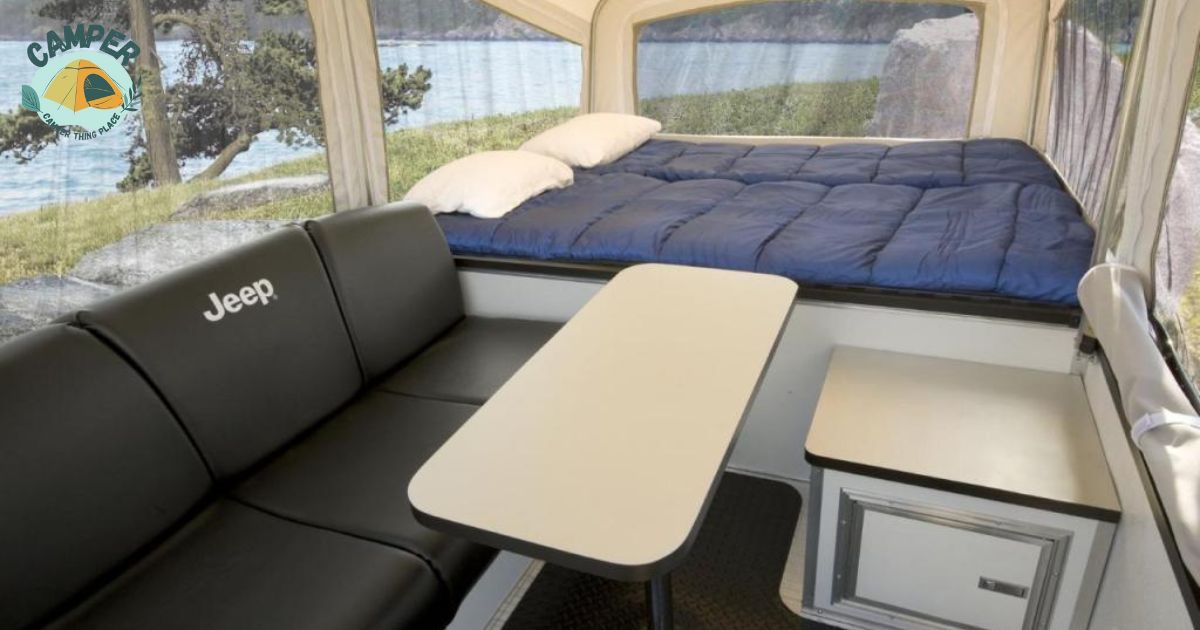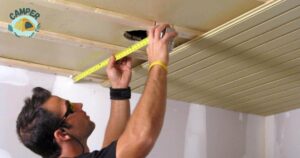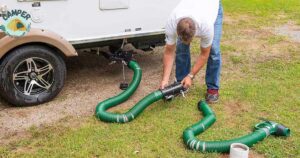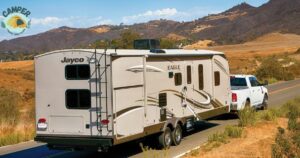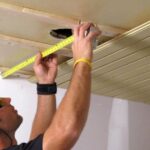A pop-up camper is a portable and collapsible camping trailer. Its compact design makes it easy to tow, and it unfolds to reveal sleeping and living spaces. With canvas walls, it offers a cozy camping experience while maintaining a connection to the outdoors.
It is a compact travel trailer that’s easy to tow. It unfolds or pops up to reveal a cozy living space with beds, a small kitchen, and seating. You might ask, How much weight can a pop-up camper bed hold? These campers are lightweight and offer a comfortable camping experience with the convenience of collapsibility.
Perfect for outdoor enthusiasts, pop-up campers provide a blend of simplicity and comfort for a memorable camping adventure. A pop-up camper bed can typically hold around 600 to 800 pounds of weight. It’s important to check the manufacturer’s specifications to ensure safe usage. Overloading the bed may lead to damage and compromise safety during travel.
Types of Pop-Up Camper Beds
Pop-up campers come with various types of beds to suit different preferences and needs. The most common is the “tent end” bed, which extends from the camper’s sides and provides a cozy sleeping space.
Another popular option is the “slide-out” bed, which smoothly extends from the camper’s body, offering extra room. Some pop-up campers feature a “dinette bed” created by converting the dining area into a sleeping space. Bunk beds are also available in certain models, ideal for families or groups.
In addition, some campers have a “gaucho bed” formed by transforming a sofa into a comfortable sleeping spot. With these diverse bed options, pop-up campers cater to various sleeping preferences, ensuring a good night’s rest during outdoor adventures.
Tent End Bed
The tent end bed in pop-up campers is a unique and popular design. These beds are typically located at the sides of the camper and extend outward, resembling tent-like structures. With canvas walls and zippered windows, they offer a camping experience close to nature while providing a comfortable sleeping space.
The tent end beds are versatile, allowing campers to enjoy the open air and panoramic views while still enjoying the security and comfort of being inside the camper. This design is perfect for those who want a more immersive outdoor experience without sacrificing the convenience of a camper.
Slide-Out Bed
The slide-out bed in pop-up campers is a convenient and space-efficient design. This type of bed is typically located within the camper’s body and can be smoothly extended or “slid out” when needed. The slide-out bed offers additional sleeping space without requiring extra setup or assembly.
It’s a practical solution for maximizing interior space, providing campers with a comfortable bed that can be easily stowed away during the day. This design is popular for its simplicity and efficiency, making it an ideal choice for those who prioritize ease of use and functionality in their pop-up camper.
Fixed beds
Fixed beds in pop-up campers are a straightforward and permanent sleeping option. Unlike convertible or fold-out beds, fixed beds remain in a set position within the camper. These beds are pre-installed and ready to use without the need for any setup or transformation.
Fixed beds can come in various sizes, accommodating different sleeping preferences. This design is convenient for campers who prefer a dedicated and always-ready sleeping area.
Eliminating the need to rearrange furniture or convert spaces each night. Fixed beds in pop-up campers provide a stable and comfortable sleeping solution, ensuring a hassle-free camping experience.
Fold-out beds
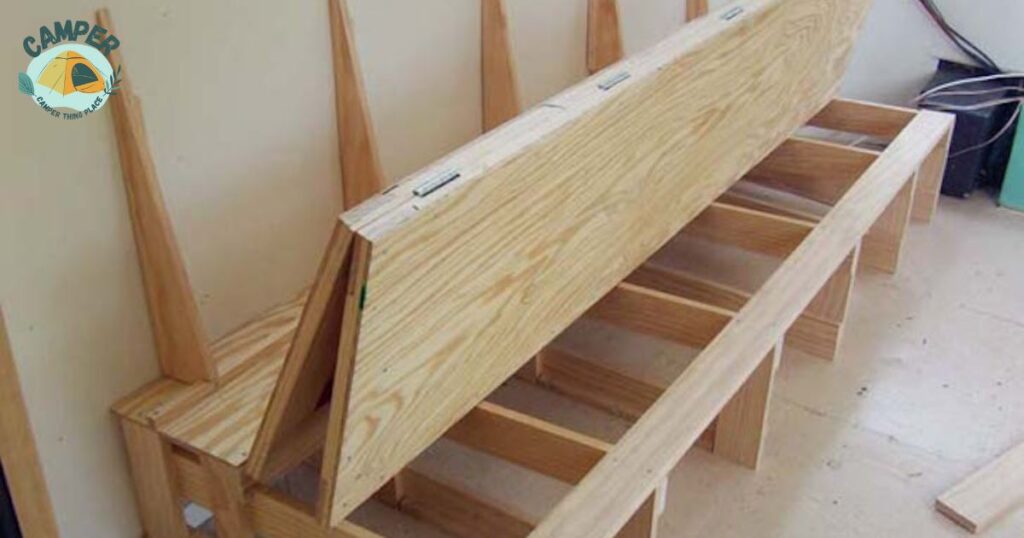
Fold-out beds in pop-up campers offer a versatile and space-saving sleeping solution. These beds are typically designed to be folded away when not in use, allowing for increased living space during the day.
When needed, the fold-out bed can be easily unfolded or extended, providing a comfortable sleeping area. This design is ideal for campers who prioritize flexibility and want to make the most of the available space in their pop-up camper.
Fold-out beds come in various configurations, with some integrated into seating areas or walls. They provide a practical and efficient way to transform living spaces, ensuring campers have both a comfortable lounge area and a cozy bed in their compact camper.
Convertible dinette beds
Convertible dinette beds in pop-up campers serve a dual purpose, transforming the dining area into a comfy bed at night. This space-efficient design eliminates the need for a separate sleeping zone. Ideal for campers valuing multipurpose functionality, it provides both a communal space for meals and a cozy sleeping spot without extra setup.
Things to Keep in Mind When Using Pop-Up Campers
When using pop-up campers, safety is key. Always check the camper’s condition before hitting the road. Ensure that the tires are properly inflated and the brakes are working well. Familiarize yourself with the setup process to avoid any difficulties at the campsite.
Keep an eye on the weather forecast, as pop-up campers may not be ideal in extreme conditions. Pack efficiently and prioritize lightweight items to prevent overloading.
Be cautious of low-hanging branches or obstacles while driving to avoid damage. Practice proper waste disposal and leave no trace at the campsite. Lastly, enjoy the flexibility and comfort that pop-up campers offer for a memorable outdoor experience.
Pop-up camps aren’t particularly roomy
Pop-up camps are tiny, not big at all. They’re snug, like a cozy blanket, but not super spacious. If you’re someone who loves lots of room, these camps might feel a bit cramped. However, the upside is they’re incredibly easy to set up
They are perfect for uncomplicated camping adventures. Despite not being roomy, they have their charm. These little camps are all about simplicity, making them a great choice for folks who prefer a snug, hassle-free camping experience.
There is no cooling or heating inside pop-up campers
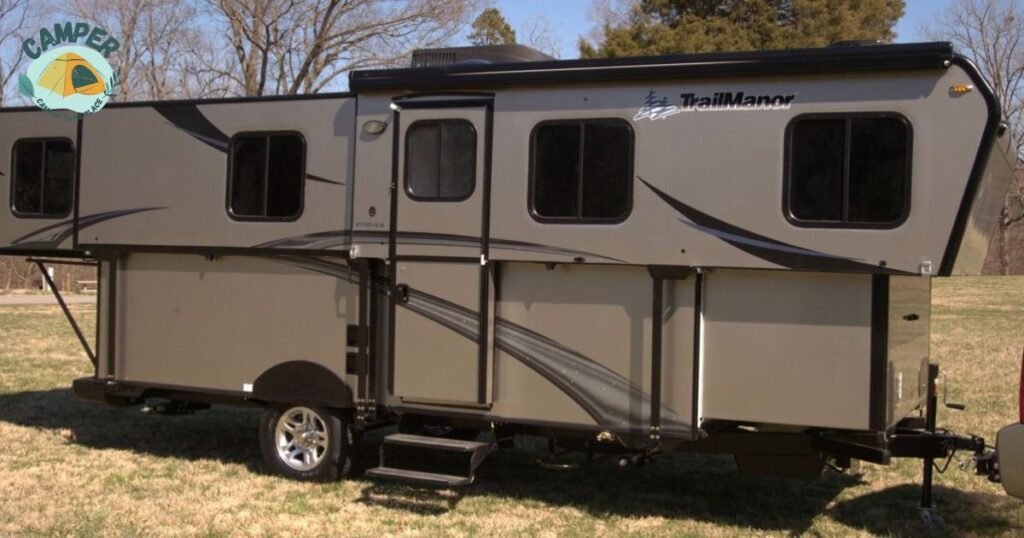
Inside pop-up campers, you won’t find the luxury of built-in cooling or heating systems. These campers are intentionally designed to be more lightweight and flexible, emphasizing simplicity over the amenities of a climate-controlled environment.
In warmer weather, ventilation through windows and openings in the camper can help maintain a comfortable temperature, but there’s no air conditioning to provide relief on scorching days. Similarly, during colder seasons, you won’t have the convenience of a built-in heater to warm up the interior. For campers seeking a more self-reliant experience, this lack of cooling and heating can be a minor trade-off.
However, it’s essential to plan accordingly based on the weather conditions you expect to encounter. If you’re camping in extreme temperatures, bringing additional gear such as portable fans or heaters becomes crucial for ensuring a comfortable stay inside the pop-up camper.
Despite these limitations, pop-up campers remain popular for their versatility and easy setup, catering to those who prioritize a simpler camping lifestyle over the comforts of a climate-controlled space.
The weather does not spare pop-up camps
Pop-up camps are not immune to the whims of weather. Unlike more robust structures, these camps are vulnerable to the elements. Rain can seep through, making it important to be prepared for wet conditions.
Similarly, strong winds may pose a challenge as pop-up camps are generally lightweight and can be affected by gusts. The lack of a solid structure means extreme weather conditions, be it scorching heat or cold, can have a noticeable impact on the camper. Camping enthusiasts opting for pop-up camps should be mindful of the weather forecast and equip themselves accordingly.
Bringing waterproof gear, securing the camp properly, and considering alternative shelter options are all part of adapting to the unpredictable nature of outdoor conditions. While pop-up camps offer flexibility and ease of use, they also require campers to be adaptable and ready to face whatever weather comes their way.
How to Find Your Pop-up Camper Beds Weight Limit
Finding your pop-up camper bed’s weight limit is important for safe and enjoyable travels. Begin by checking your camper’s manual, usually found in a storage compartment. Look for a label or tag on the bed frame or mattress that specifies the weight limit.
If the information isn’t there, contact the manufacturer for guidance. Keep in mind that weight limits may vary for different models, so ensure you’re checking the right one. Avoid exceeding the specified limit to prevent damage and ensure a comfortable night’s sleep.
Safety first – knowing your pop-up camper bed’s weight limit is a small step that contributes to a worry-free camping experience.
Safety Tips for Pop-up Camper Beds
When using pop-up camper beds, safety is essential. Always inspect the bed’s condition before use. Make sure all latches and supports are secure. Follow the manufacturer’s guidelines for weight limits.
Avoid overcrowding the bed. Use sturdy bedding and secure it properly. Teach children to climb up and down carefully. Keep the area around the bed clear to prevent tripping hazards. Always park on level ground to ensure a stable sleeping surface.
Double-check that the camper is properly leveled. If you feel any discomfort or instability, address it immediately. By following these safety tips, you can enjoy a secure and restful experience in your pop-up camper bed.
Newer vs. Older Models
| Feature | Newer Models | Older Models |
| Construction Materials | Lightweight, durable materials | Heavier materials |
| Weight | Generally lighter | Heavier |
| Setup Mechanism | Easier and quicker setup | May require more manual effort |
| Interior Amenities | Modern amenities and designs | Basic features |
| Storage Space | Optimized storage solutions | Limited storage options |
| Towing Compatibility | More compatibility options | Limited compatibility |
| Insulation | Improved insulation for comfort | Basic insulation |
| Technology Integration | Integration of modern tech | Limited or no tech features |
| Cost | Higher cost | Potentially lower cost |
| Resale Value | Holds value well | May depreciate more quickly |
Keep in mind that these are generalizations, and there can be exceptions based on specific models and brands. Always consider your individual camping needs and preferences when choosing a pop-up camper.
How to Make Your Pop-Up Camper More Comfortable
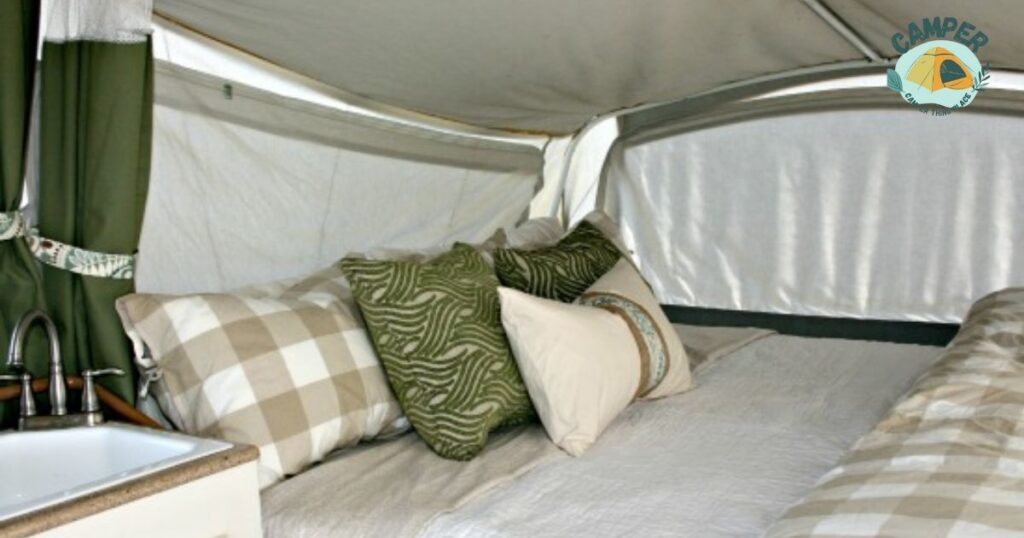
Follow these tips to make pop-up camper more comfortable
Quality Mattress
Choose a comfy, portable mattress that fits your pop-up camper, prioritizing durability and features like temperature regulation. Regular maintenance ensures longevity.
Organized Storage
Organizing storage in your pop-up camper is crucial for creating a comfortable and efficient living space. Utilize bins and organizers to keep essentials easily accessible while maximizing available space. Consider multi-functional storage solutions and secure loose items during travel to maintain a tidy and organized camping environment.
Cozy Seating
Creating cozy seating in your pop-up camper is essential for a comfortable camping experience. Invest in portable cushions or foldable chairs to enhance seating comfort while saving space. Add a personal touch with soft blankets or throws to create a warm and inviting atmosphere in your camper.
Effective Lighting
Effective lighting transforms the ambiance of your pop-up camper. Install soft, adjustable lighting such as battery-operated lamps or LED string lights for both functionality and comfort. Thoughtful placement enhances the overall atmosphere, creating a pleasant and well-lit living space during your camping adventures.
How Much Does a Pop-Up Camper Weigh?
The weight of a pop-up camper, crucial for efficient towing and overall performance, can vary widely depending on its size, design, features, and construction materials. On average, smaller pop-up campers can weigh around 1,000 to 2,000 pounds (450 to 900 kg), while larger and more feature-packed models may weigh between 2,000 and 4,000 pounds (900 to 1,800 kg) or even more.
Ensuring the structural integrity and longevity of your camper involves proper maintenance, including addressing specific concerns like Reseal A Camper Roof. It’s important to note that the weight of a pop-up camper is typically specified as the dry weight, which means the weight of the camper without any additional cargo, water, or supplies.
The actual weight when loaded with personal belongings, water, propane, and other camping essentials will be higher. Always check the specific weight specifications for the particular model you are interested in, as it can vary significantly between different manufacturers and models.
Exceeding the Weight Limit
Exceeding the weight limit of any vehicle, including a pop-up camper or RV, can lead to serious safety issues and potential damage to the vehicle. Weight limits are established based on the manufacturer’s specifications, and exceeding these limits can result in the following consequences:
Safety Risks
Exceeding weight limits can compromise the vehicle’s stability, handling, and braking capabilities. This increases the risk of accidents, especially during emergency maneuvers.
Structural Damage
The chassis, suspension, tires, and other components of the pop-up camper are designed to handle a specific weight. Exceeding these limits can lead to structural damage over time, reducing the overall lifespan of the camper.
Tire Failure
Overloading a camper puts extra strain on the tires, increasing the risk of tire blowouts. Tires are designed to carry a specific load, and exceeding this capacity can lead to catastrophic failure.
Legal Consequences
In many regions, exceeding the weight limit is a violation of traffic regulations. This can result in fines, penalties, and other legal consequences.
Voided Warranty
Exceeding the manufacturer’s weight limits may void the warranty on the camper. This means that any damage or issues resulting from overloading may not be covered by the warranty.
To avoid these problems, it’s crucial to know and adhere to the specified weight limits for your pop-up camper. This information can usually be found in the owner’s manual or on a placard attached to the camper.
If you find that your current setup exceeds these limits, consider redistributing weight, removing unnecessary items, or investing in a larger, more robust camper that can accommodate your needs safely.
Always prioritize safety and follow the guidelines provided by the manufacturer to ensure a smooth and secure camping experience. If you have specific concerns or questions about the weight capacity of your pop-up camper, it’s advisable to consult with the manufacturer or a qualified RV technician for guidance.
Extra Support for King-sized beds
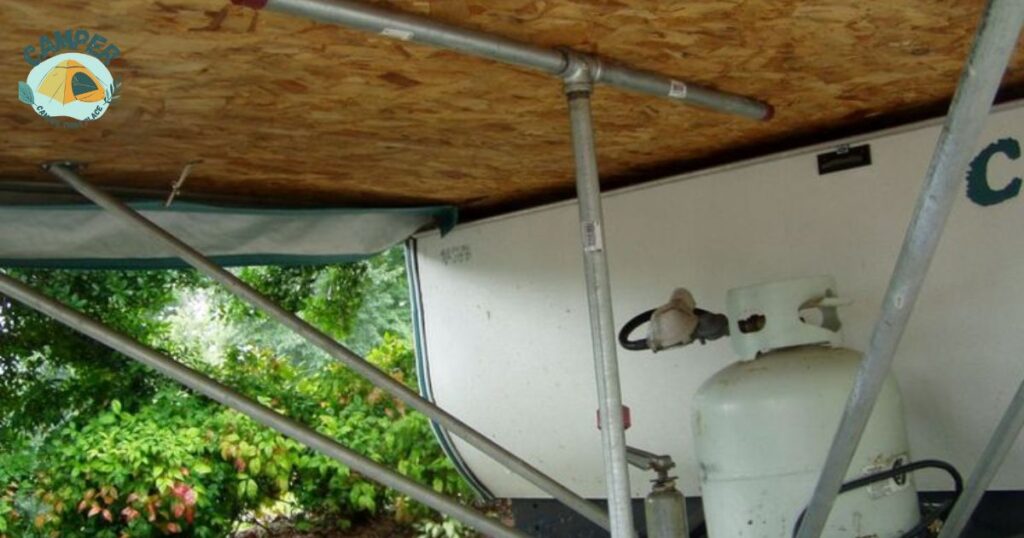
When it comes to providing extra support for a king-sized bed, especially in the context of a pop-up camper or RV, there are a few considerations you might want to keep in mind:
Bed Frame
Ensure that the bed frame is sturdy and designed to support the larger dimensions of a king-sized mattress. Some pop-up campers may have adjustable or foldable bed frames that provide additional support when extended.
Supportive Foundation
Consider using a supportive foundation beneath the mattress. This could be in the form of a solid platform or a system of slats that distribute weight evenly. This helps prevent sagging and provides better support for the mattress.
Reinforcements
Some RV or camper owners choose to add reinforcements to the existing bed frame. This could involve additional bracing, strategically placed support legs, or other modifications to enhance the overall structural integrity.
Mattress Type
The type of mattress you use can also impact support. Memory foam mattresses, for example, may require a more solid foundation compared to traditional innerspring mattresses.
Additional Supports
Depending on the design of your pop-up camper, you may explore options for additional supports that can be added or adjusted when the bed is in use. This could include collapsible or foldable leg supports.
Custom Modifications
In some cases, RV or camper owners may opt for custom modifications to improve bed support. This could involve consulting with a professional to assess the camper’s structure and make appropriate enhancements.
Always be cautious when making modifications to your camper, as it’s essential to maintain the overall safety and structural integrity of the vehicle. If you’re unsure or uncomfortable making these modifications yourself, consider consulting with a professional or the manufacturer for guidance specific to your camper model.
Four Things to Remember About Pop-up Campers
- Adhere to the manufacturer’s specified weight limits for your pop-up camper to ensure safety, prevent damage, and comply with legal regulations.
- Familiarize yourself with the proper procedures for setting up and taking down your pop-up camper. Follow the manufacturer’s guidelines to avoid damage and ensure a smooth camping experience.
- Regularly inspect and maintain your pop-up camper, including checking for leaks, ensuring proper seals, and addressing any wear and tear. This helps prolong the life of your camper and prevents unexpected issues during your trips.
- Distribute weight evenly inside the camper and avoid exceeding cargo capacity. Proper loading enhances stability on the road and prevents strain on the camper’s components.
Frequently Asked Questions
How much weight can you put on top of a pop-up camper?
The weight limit for a pop-up camper’s roof is typically around 100-200 pounds, but it’s essential to check your camper’s manual for the specific limit.
How many can sleep in a pop-up camper?
The sleeping capacity of a pop-up camper varies, typically accommodating 2 to 8 people, depending on the model and size.
How thick are camper frames?
Camper frame thickness varies, but they are generally made of steel and can range from 2 to 6 inches thick, depending on the specific design and type of camper.
Can the weight capacity of a pop-up camper bed be increased or modified?
Increasing or modifying the weight capacity of a pop-up camper bed is not recommended, as it may compromise the structural integrity and safety features designed by the manufacturer.
Are there variations in weight limits for pop-up camper beds based on models?
Yes, there can be variations in weight limits for pop-up camper beds based on different models. It’s essential to check the manufacturer’s specifications for your particular camper.
Final Thoughts
The weight capacity of a pop-up camper bed is a critical consideration for a safe and enjoyable camping experience. Understanding the limitations of the bed ensures that you can comfortably rest without risking damage to the camper or compromising your safety.
Always follow the manufacturer’s guidelines and take into account the combined weight of occupants to make informed decisions when setting up your pop-up camper. So here this question is solved how much weight can a pop-up camper bed hold? To wrap it up, knowing how much weight a pop-up camper bed can hold is essential for responsible and stress-free camping.
Prioritize safety by avoiding overloading the bed and following the recommended weight limits to prevent any structural issues. By being mindful of these factors, you can maximize the enjoyment of your camping trips while maintaining the longevity and functionality of your pop-up camper.

Jackson Ray, a seasoned blogger with a decade of experience, is the creative mind behind “camperthingsplace.com.” Explore his wealth of insights and passion for camping through engaging content on the website.
